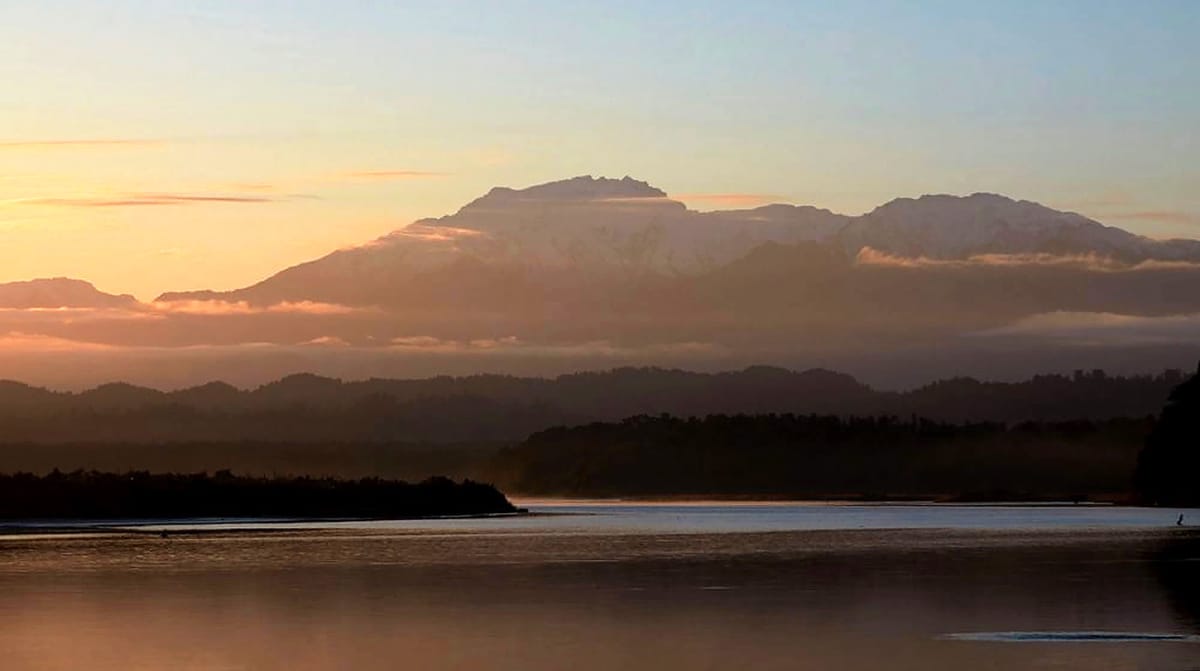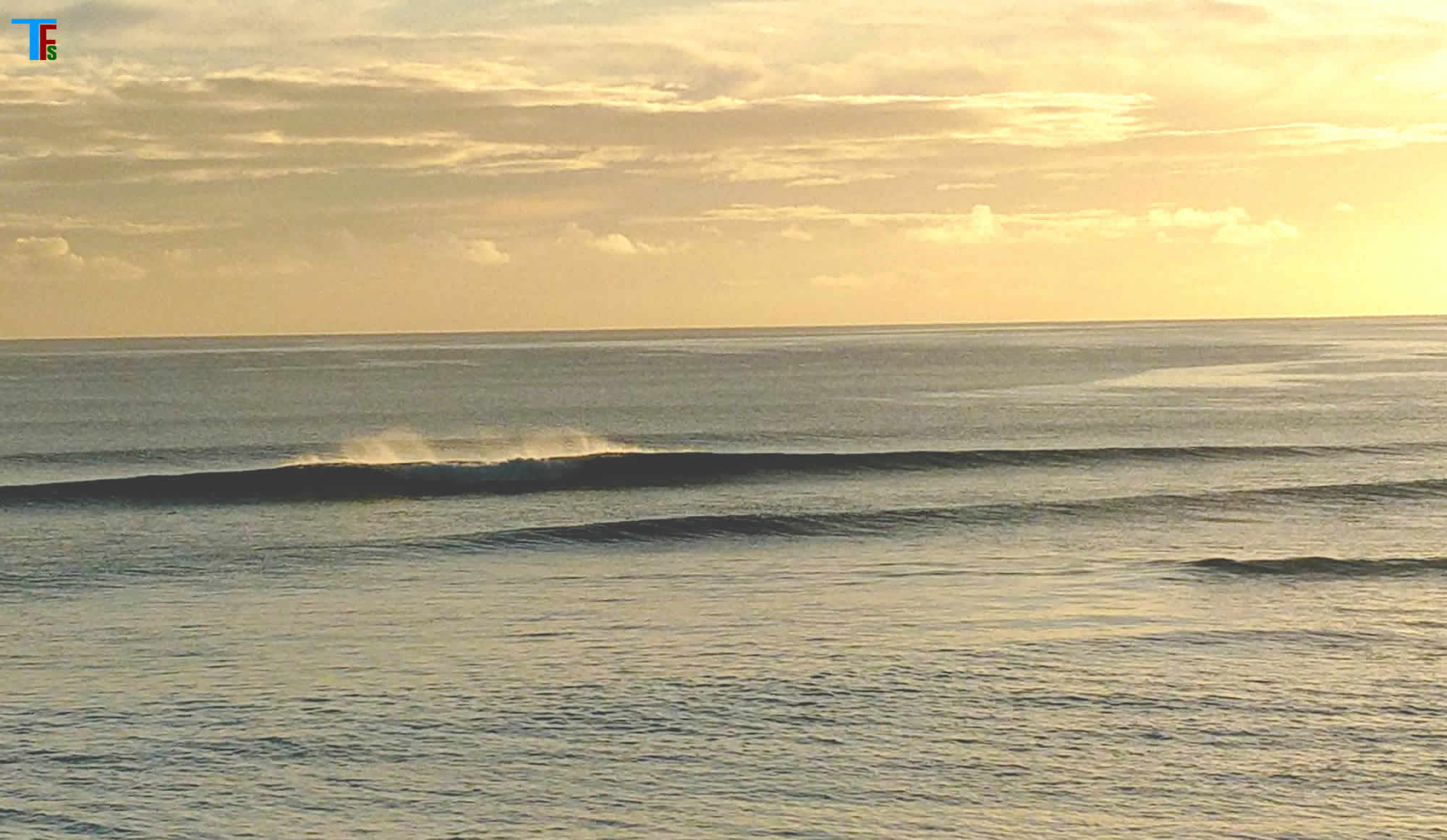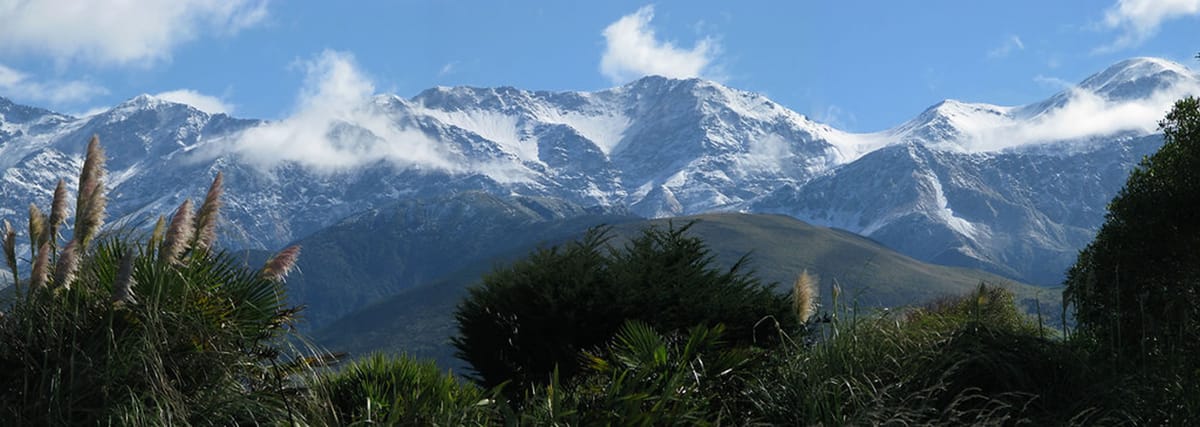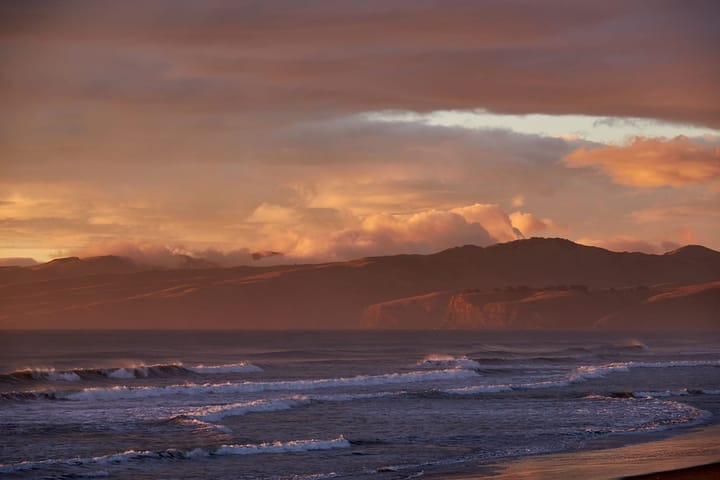The Fragile Sea Newsletter TFS #03
We discuss AGI and machine sentience, copyright, developments in biotech, space weather, and much more in our third bi-weekly newsletter

Welcome!
The web version for mobile and desk is here
(the references will pop up when selected - not available on the email version)
It's leap year day! Welcome to the third news'letter for The Fragile Sea.
This week is an experiment with a (slightly !) shorter format.
Quickreads

- The big news in AI over the past week was the release by OpenAI to a limited number of creators, of Sora, a text to video tool. We discuss some of its neat features, also some concerns that have been raised.
- Other areas of AI also moved rapidly ahead, we discuss AI and memory, and V-JEPA, a video predictive architecture, that seems to be one step towards real-time processing through creating a simulated construct of reality - similar to how our brains work (as we discussed in TFS#02).
- There are some neat new developments in biotech and agritech, and a recent space weather incident.
- The freefall continues in media and publishing, concurrent with the rise in the creator economy - we check a few sources.
- The Economist wins my award for the best source article this newsletter, a poorer outlook for stock markets - maybe not what anyone wants to hear.
- We look at new studies on greed, power, and anger at work.
- In Around the houses and corporates, we note new studies of interest from investment firms, and in Around the halls, ongoing developments in enabling crypto, blockchain and the metaverse, from BIS, IMF and other institutions.
- In Discussion, we suggest four powerful global forces at work, AI and jobs, the state of patenting and copyright, an economic indicator, and briefly, defence systems, from a remote PoV - in fact, from the Easter Islands.
- I wrap up in Things that go wow, and What’s coming up, and finish with a short Kokinshū poem.
- TFS#04 will be out on Thursday, 14th March at 8:00pm, UTC.
Let's go!
AI, Devtech, Comms

Sora
The release of the OpenAI text-to-video AI model, Sora, this past week to redteamers (teams that try to find vulnerabilities and anomalies), and a limited number of creators, is another step to machines able to create stories at will and realise them in hi-res moving pictures. Limited to one minute long, in a wide range of resolutions and aspect ratios up to a maximum 1920x1080 pixels, the model has some unique features, such as creating up to four stories in reverse from the final scene, back to four different starting points, and stories.
The one-minute videos are created from a text prompt, that is, a human asking the model to create a story. The OpenAI website notes "Sora is able to generate complex scenes with multiple characters, specific types of motion, and accurate details of the subject and background. The model understands not only what the user has asked for in the prompt, but also how those things exist in the physical world" [1]
If this is not enough, the upcoming features are mind blowing, listed here [2]. Interestingly, DeepBrain AI, a "deep-learning-based video synthesis company and innovator of AI-generated virtual humans" (essentially a competitor), provides a good analysis of how to use it, calling it ‘groundbreaking’, and then proceeds to contrast it with their own AI Studio model, listing its advantages over Sora [3]. This is a good way to get some counterbalance, but given the future featureset of Sora in the reference above, any perceived advantages are not likely to prevail for very long.
Steven Levy from Wired, called it ‘impressive’, but, as yet, with only a basic grasp of narrative and cinematic grammar, with unexpected shot changes [4], and issues in scene continuity. The graphics are certainly outstanding.
Levy also raises the issue of copyright and ‘publicly available content’, and the potential for it to be a "misinformation train wreck". The New Scientist and other outlets have also raised the potential for deepfakes during upcoming election cycles, this is not an issue that Sora inherits alone [5], [6], [7], [8].
Other AI developments
Nvidia announced Chat with RTX - a "demo app that lets you personalize a GPT large language model (LLM) connected to your own content—docs, notes, videos, or other data… you can query a custom chatbot to quickly get contextually relevant answers. And because it all runs locally on your Windows RTX PC or workstation, you’ll get fast and secure results" [9].
Meta’s VP & Chief AI Scientist, Yann LeCun, also announced the Video Joint Embedding Predictive Architecture (V-JEPA) model, an "early example of a physical world model (that) excels at detecting and understanding highly detailed interactions between objects" [10]. This is exciting to me because it connects to the discussion in TFS#02 on how humans create symbolic representations of the world, and then test them through micro-predictions about external reality, every micro-second, anticipating in advance, before being conscious of what the next action or occurrence might be.
The Meta announcement notes "This early example of a physical world model excels at detecting and understanding highly detailed interactions between objects… Your internal world model - a contextual understanding based on a mental model of the world - predicts these consequences for you, and it’s highly efficient" [10]. This is a further step towards AI real-time cognitive processing of spatial environments, important to the potential for achieving sentience in machines.
Another development is OpenAI’s limited rollout of ‘memory with ChatGPT': "We’re testing memory with ChatGPT. Remembering things you discuss across all chats saves you from having to repeat information and makes future conversations more helpful. You’re in control of ChatGPT’s memory. You can explicitly tell it to remember something, ask it what it remembers, and tell it to forget conversationally or through settings. You can also turn it off entirely. We are rolling out to a small portion of ChatGPT free and Plus users this week to learn how useful it is. We will share plans for broader roll out soon"[11].
How close is AI to AGI machine sentience?
All these steps on the path are bringing AI awfully close to the tools and capabilities necessary for a shot at artificial general intelligence (AGI) - consciousness basically, in machines.
We discussed the requirements for AGI sentience at length in TFS#02. It's time for me to go back and re-read ‘Neuroscience-Inspired Artificial Intelligence’ by Demis Hassabis, CEO of DeepMind, and colleagues, published in 2017, for the umpteenth time, to see how close we are [12]. Other more recent papers are also worth the time [13], [14], [15], [16].
OpenAI have offered funding for researchers to work on the ‘Superalignment problem’, where, in a not so distant future, humans will need to supervise AI systems much smarter than them: "Solving this problem is essential for ensuring that even the most advanced AI systems in the future remain safe and beneficial to humanity" [17]. The 49-pager is a good opener to the issues [18].
A good second paper (Feb 2024) also asks: "… as models grow increasingly sophisticated, they will surpass human expertise, and the role of human evaluation will evolve into non-experts overseeing experts. In anticipation of this, we ask: can weaker models assess the correctness of stronger models?"[19].
To me, it seems that further work is required on clarifying and refining semantics for ‘weak’ models and ‘strong’ models, and their interactions.
Emergent developments
Scientific American have three amazing articles in February on AI which are well worth reading:
‘Scientists Are Putting ChatGPT Brains Inside Robot Bodies. What Could Possibly Go Wrong?’ [20]. As I mentioned in the TFS#02, the ability to take in large volumes of data in realtime and make sense of the world around us, is a next step for AI but will need enormous investment in compute to do so.
‘How AI Bots Could Sabotage 2024 Elections around the World’ - "AI-generated disinformation will target voters on a near-daily basis in more than 50 countries, according to a new analysis" [21], quoting a study that notes "The potential fallout, the study authors say, could affect election results in more than 50 countries holding elections this year, from India to the U.S".
‘Europe’s New AI Rules Could Go Global—Here’s What That Will Mean’ [22]. We will discuss this in Part 6: Ethics, oversight and legal, but essentially this article has experts discussing where the regulations may fall short.
Is AI entering a hype cycle?
I found an interesting article on AppDeveloper by Richard Harris, contending that AI is going through the classic (overheated) tech hype cycle and will cool somewhat in certain aspects in 2024 [23]. I don’t disagree - adding the word AI to the front of everything seems to be happening, and when looking for what AI is doing there, one encounters tons of words and little detail.
Other Devtech developments
In other devtech news, there's some discussion around Google retiring cached links for web pages and what that might mean. One article from Ron Amadeo on ArsTechnica maintains that Google will no longer back up the Internet: "Cached webpages are dead: Google Search will no longer make site backups while crawling the web" [24]. Amadeo notes that it was probably unrealistic to expect Google to continue backing up the entire web in any case (see also [25]).
A couple of interesting articles by Luis Minvielle on WeAreDevelopers also: ‘6 Emerging Technologies We’ll Learn About in 2024’ [26], and ‘5 Future Technologies Coming in 2024’ [27]. Nanotechnology is one - I believe also that nano will be big in 2024.
Science, Biology, Envirotech

Drug and therapy startups
Labiotech offers a Best in Biotech web page of startups and companies to watch for in 2024 in gene therapies, cell therapies, new drug discoveries, and other biotech ventures. It is well worth a visit [28]. One article, ‘Five AI drug discovery companies you should know about’, is particularly interesting [29].
Antibiotic resistant genes
A February 22nd, 2024 paper released by Duke Pratt School of Engineering is kind of scary: ‘Copies of Antibiotic Resistance Genes Greatly Elevated in Humans and Livestock’ [30].
As reported, "the study finds a smoking gun for the spread and evolution of antibiotic resistance", and, "they discovered that those living in places with higher levels of antibiotic use — humans and livestock — are enriched with multiple identical copies of antibiotic resistance genes, while such duplications are rare in bacteria living in wild plants, animals, soil and water"[31]. An earlier study concurs [32].
Other biotech developments
University College London researchers have synthesised a new chemical compound essential to all living things, in a lab, "in conditions that could have occurred on early Earth, suggesting it played a role at the outset of life" [33], [34].
MIT have reported on a newly released study that presents a new model to identify drugs that shouldn’t be taken together: "Using a machine-learning algorithm, researchers can predict interactions that could interfere with a drug’s effectiveness" [35]. The mode of discovery and use of ML are clever uses of combining technology and well-designed experiments.
This connects strongly for me with studies of pesticides where the mix of ingredients, such as an active component, and adjuvants added for some benefit - such as spreading more evenly, make the compound 1000s of times (yes 1000s) more toxic than the active component itself. Adjuvants are not tested in the USA or Europe for toxicity with the active component, a stupendously unbelievable situation. More about this later in the year.
Air, Food, Water

AgriFoodTech
A useful new paper has been released (Open Access) on a tongue twister: AgriFoodTech, which asks the question: are start-ups the new drivers of food systems transformation? It provides an overview of the state of the art and is a status update to place "AgriFoodTech start-ups on the radar of the broader scientific community. We believe that they are still relatively understudied and perhaps also underrated players in agrifood innovation systems and the transformation of food systems" [36].
A corollary is a December 2023 paper entitled ‘FoodTech startups: Technological solutions to achieve SDGs’, noting, "the concept of FoodTech arises, which are startups that use new technologies to revolutionize the food sector, in favor of building a new market that is smarter, healthier, sustainable, dynamic and agile" [37]. The UN’s 17 Sustainable Development Goals are here [38].
I have been looking for these sorts of analyses for some time, and plan to write more about AgTech later in the year.
Energy, sun, space, physics, weather

Recent solar activity
Spaceweather.com is a brilliant web. Scientists have been monitoring a giant sunspot AR3590 which has grown bigger over the weekend of 24-25 Feb, now at 60% the size of the Carrington Event of 1859 [39]. British scientist Richard Carrington observed an event that became the biggest ever recorded geomagnetic storm, setting fire to telegraph stations, shorting grids, and creating auroras seen from Hawaii to Canada [40], [41].
The solar superstorm of July 2012 missed Earth, in its rotation, by two weeks. If it had hit, the outcome would have been existential and truly catastrophic [42], [43]. Other solar storms in history have been discovered in ice and tree rings, and attest to the powerful effects of the sun on earth [44], [45], [46]. In February 2022, SpaceX lost 40 Starlink satellites to a geomagnetic storm, and in March 1989, a solar flare generated a geomagnetic storm that took out Hydro-Québec's electricity transmission system and left six million people without power for nine hours [47], [48], [49].
What makes the current activity so interesting is several unusual factors:
i) The sun’s solar cycle is coming up to its most active in over 20 years, and reported in 2023 to be ‘arriving early’ [50], [51], [52]. A new study predicts it is likely to peak in 2024 [53], [54] - this is a really good study, finding a new way to predict solar cycles.
ii) Spaceweather.com reports that the growing sunspot, being at a current 60% intensity of the Carrington Event, if it flares and the resultant coronal mass ejections (CMEs) hit the earth, would cause problems for satellites, power grids, and internet connectivity. "That's why forecasters are carefully watching this sunspot".
iii) Solar flares did indeed hit the earth in February, reported as "the strongest in seven years" [55] . The earth is constantly bathed in solar activity at varying magnitudes, but this was somewhat unusual. Twin solar flares from the sun (others reported three solar flares [56]), occurred on Feb 21-22 at the same time as widespread cellphone outages throughout the United States [57]. (The outages were not caused by the flares though - see below).
Solar flares and CME
There’s a lot to understand about the science. Coronal mass ejections (CMEs) are not solar flares though they can accompany them. Solar flares travel near the speed of light so they reach us in about eight minutes, whereas CMEs travel slower [58]. According to the National Oceanic and Atmospheric Administration (NOAA), "Coronal Mass Ejections (CMEs) are large expulsions of plasma and magnetic field from the Sun’s corona. They can eject billions of tons of coronal material and carry an embedded magnetic field (frozen in flux) that is stronger than the background solar wind interplanetary magnetic field (IMF) strength. CMEs travel outward from the Sun at speeds ranging from slower than 250 kilometers per second (km/s) to as fast as near 3000 km/s. The fastest Earth-directed CMEs can reach our planet in as little as 15-18 hours. Slower CMEs can take several days to arrive" [59].
If a strong CME collides with the earth‘s protective magnetosphere, it compresses the magnetosphere, creating a geomagnetic storm, and sends a burst of particle radiation into the earth’s upper atmosphere. As the radiation interacts with gas molecules, they release light, which essentially creates magnificent auroras, along with any damage caused. It is thought that the first of two or more CMEs colliding (known as CME cannibalism) may clear the way for the second and further CMEs, weakening the magnetosphere, and leading to the most severe damage potential for grids, networks, and electrical equipment, through geomagnetically induced currents (GIC) [60], [61].
Given that GICs can last only a microsecond and even then cause untold damage to networks and grids, and that the reported network outages appeared around the same time as the solar flares, it would seem to warrant more investigation, however any connection between the flares and the network outages was comprehensively ruled out by NOAA [62]. They did note, however, that there were three back-to-back radio blackouts in response to the flares, over the Pacific and Indian oceans, for around an hour on the sunlit side of earth. They produced a wide area blackout of high frequency communications, as well as likely degradation of low-frequency comms, for example, used by aircraft in transit overseas.
That should tell us how sensitive and vulnerable our communications and power systems are to solar activity. The connection is that our global grids are upwards of 40 years old, and some of the hard-to-replace major components such as substations become brittle and more vulnerable with age [63]. As we noted in TFS#01, global grids urgently require updating for many reasons, including clean energy transition [64], [65], [66], but also to protect against GIC. Thankfully, some work is under way [67], [68], but it’s not enough.
Lloyds of London provide an excellent 21-page assessment of risk and vulnerability, stating that "a Carrington-level, extreme geomagnetic storm is almost inevitable in the future" [69].
It’s simple, we’re not doing enough. We could lose the fridge, the beer, and much more, hospitals, sewerage systems and nuclear waste management, nothing much to be concerned about; life as we know it, Jim. I jest, to lighten the tone.
Media, publishing, social, gaming

Wow is all I can say. The freefall of jobs in traditional media and the rise of online creators is spectacular. On the one hand, I almost hate to look, while on the other, I rejoice in the explosion of new voices. This is just a representative sample across around 50-80 media and social outlets across the past week:
- ‘The great restructuring of digital news media’ The current, Zac Wang [70]
- ‘Is social-first news part of publishing’s future?’ The media leader [71]
- ‘World Creative Rankings 2024: advertising’s top companies, campaigns & people announced’ The Drum [72]
And some earlier sources in Q3 2023:
- ‘As social media turns away from the news, publishers meet audiences on other channels’ Reuters Institute, Oxford [73]
- ‘The news is fading from sight on big social media platforms – where does that leave journalism?’ The Conversation [74]
I stopped when it started to get depressing, into job losses this past week in the media. What, with fake media worries, over 40 elections worldwide this year, and all the rest, the sources of truth are more fragmented.
I loved reading this one, it cheered me up: ‘What Is a Content Creator? The What, Why and How of the Creator Economy’. State of Digital Publishing (SODP) [75].
And also from SODP, a very useful guide: ‘Google News SEO Guide 2024: Best Practices for News Publishers’ [76].
the ‘zines

The ‘zines were quiet for me these past two weeks. The Economist posted an analysis on where corporate profits have came from over the past ten years, and the unlikely event of a continuing stockmarket record performance, entitled ‘Stockmarkets are booming. But the good times are unlikely to last’ [77].
It’s clear that the stock market gains of the past few years may not have a future. Can it be that cheap money and tax cuts are the only factors that have fuelled profits? Where do we go from here? I can’t fault the research, however depressing it may sound. Even so, it wins my award for the best source article this newsletter.
Psych, philos, language, neuro, mind

The neuroscience of greed
PsyPost has reported a new study on ‘The neuroscience of greed: A glimpse into our brain’s reaction to fear and desire’, noting from the study "These findings lay the groundwork for future research aimed at unravelling the intricate neural networks that govern greed and its effects on human behaviour" [78].
Maybe it connects with another new study on ‘the surprising relationship between cynicism and power’, which asks "does a cynical view of human nature influence an individual’s motives for power and their eventual attainment of it?" [79]. The study itself is entitled ‘Cynical people desire power but rarely acquire it: Exploring the role of cynicism in leadership attainment’ [80].
If, like me, you want to skip to the end to find out, I got sidetracked by the Big Five inventory they used, which was developed to assess the most global personality domains in the adult population, the so-called Big Five trait domains: extraversion, agreeableness, conscientiousness, neuroticism (vs. emotional stability), and openness to experience [81], [82]. Right.
Anyway, the paper notes "we have demonstrated that cynicism has a prospective effect on power attainment", but whether the reverse is true, i.e., that power can shape cynicism as well, is an open question apparently, as is "whether failing to attain power (e.g. being passed over for a promotion) could contribute to cynicism" [83]. It’s strange that the word ‘sarcasm’ is not found once in the paper; it seems to me that cynics fall easily into sarcasm.
Anger at work
Perhaps we should all just be nice to each other at work. Another new study entitled 'Anger at work' notes, "A large body of work suggests that workers who express anger are judged to be competent and high status, and as a result are rewarded with more status, power, and money. Our findings consistently run counter to the current consensus… We find that when men and women express anger they are sometimes viewed as powerful, but they are consistently viewed as less competent… anger expressions at work are perceived as inappropriate, an overreaction, and a lack of self-control. Moreover, we find that people hold negative attitudes toward workplace anger expressions, citing them as relatively more harmful, foolish, and worthless compared to other emotional expressions" [84], [85]. Not much room there for doubt.
The Groves of Academe

The University of Zurich has published a study on live music, finding "Live music elicits stronger and more consistent activity in the amygdala than recorded music, indicating heightened emotional responses" [86], [87].
I am sure somewhere in my brain I already sensed that live music was more exciting than recorded music, but now I know for sure. The weird connection is to a paper from 2020 that states there are "at least 13 dimensions (that) organize subjective experiences associated with music across different cultures" [88].
That led me to a 2018 paper on ‘Maps of subjective feelings’ which has probably the best tree diagram (more like a bush) I have seen on positive and negative emotions, a fascinating tangle of causative connections that can evoke emotions, such as ‘being dazzled’, ‘hangover’, and ‘being conscious’, all of which I can relate to [89].
Around the houses and corporates

It’s fascinating how a concern of two weeks ago, namely, disinflation, simply washes away from commentary, the minute its counterpoint (i.e., persistently higher inflation) is reported. I haven’t seen much these past two weeks on disinflation, whereas prior, it was all over the place.
Blackrock has a good commentary and pdf download on ‘Japan stocks: can go higher’ [90].
Two excellent articles from Goldman Sachs: ‘How the world’s record share of elections will ripple through the economy’ [91] and ‘The global market for humanoid robots could reach $38 billion by 2035’ [92]. Seems to me like the market for humanoid robots will rise to more than that.
Jan Hatzius (Goldman Sachs - see [93]) has two good articles: ‘Global Views: Cuts Are Coming’ [94], and ‘Global Views: Too Much of a Good Thing?’ [95].
As usual, Morgan Stanley produces a wealth of high-quality papers. These past two weeks have been no exception [96].
Dan Morehead’s Pantera Blockchain Letter is always insightful, the latest here: ‘The Absence of Bad Things’ [97].
Libby Cantrill and Richard Clarida at Pimco weigh in on the US Bond Market: ‘Bond Markets Overlook U.S. Debt Trajectory, For Now’ [98] .
UBS launch their 25th ‘Global Investment Returns Yearbook 2024’ in conjunction with London Business School, ‘an authoritative guide to historical long-run returns’ [99].
Around the halls

It seems that BIS, IMF, and other institutions are preparing for the ‘inevitability’ of crypto and the metaverse.
Firstly, BIS released an interesting paper on ‘The economic implications of services in the metaverse’ noting that "If the metaverse does succeed, it could mean: (i) a blurring of lines between the tradable and non-tradable sectors, (ii) greater cross-border economic integration and (iii) new demands on payment services… In principle, retail fast payment systems, retail central bank digital currencies or tokenised deposits could be designed to support services in the metaverse" [100] .
This is a fascinating paper, it discusses the origins and growth of the metaverse, including its inspiration in fiction; selected types of services in the metaverse; payments for metaverse-related activities; and implications for public policy.
Secondly, the IMF, reports remarks by the IMF Managing Director Kristalina Georgieva in December 2023: "After enlightening discussions with member countries, the IMF and the Financial Stability Board published a report last September [101] offering guidance on rules for crypto assets…These rules are not meant to return us to a pre-crypto world, nor to squash innovation. Not all in crypto was tainted by fraud, just like the Wild West was not only about crooks, despite their legendary exploits. Good rules can spur and guide innovation… " [102].
Thirdly, it's fascinating to watch U.S. Securities and Exchange Commission (SEC) Chairman Gary Gensler, after the successful launch of U.S. bitcoin exchange-traded funds (ETFs), and the expectation that he will ‘drag his feet’ on Ethereum and other crypto ETF’s [103]. It’s only a matter of time…
Discussion

The world is moving rapidly towards an uncertain era, and a time of great change, in my view. The Fragile Sea is expressly non-political, so these remarks are not meant politically.
Apart from the appalling loss of life and continuing conflicts around the world, I see four powerful connections coming together ('the four powers'):
1. AI is entering a period of hype but is already disruptive
The productivity gains and efficiencies to be achieved, the job re-organisations, and the re-skilling needed, are all going to meet somewhere and maybe clash. Can we head that off? Not sure. Every genuine new paradigm brings disruption to existing labour markets but also new job opportunities.
Kaye Whiting, reporting on Davos 2024, noted that "by 2027, businesses predict that almost half (44%) of workers’ core skills will be disrupted… AI is widely reported to be a key disrupter, but other factors, including the green transition and geo-economic conditions, will also see "churn" for almost a quarter of jobs by 2027".
The Forum's Global Risks Report 2024 found that "lack of economic opportunity" ranked as one of the top 10 biggest risks among risk experts over the next two years [104].
These three WEF reports are good to get one’s head around:
- ‘Global Risks Report 2024’ 10 Jan 2024 [105]
- ‘The Future of Jobs Report 2023’ 30 Apr 2023 [106]
- ‘The Future of Growth Report 2024’ 17 Jan 2024 [107]
2. AI is going to come bang up against copyright and data sources
The lawsuits have begun [108], [109], [110]. This is about more than royalties, it’s about standing in the maelstrom of a hurricane of sweeping change, wondering what has been, or will be, protected, as it all flies past.
But the law will eventually prevail, and what then? See for example:
- ‘Are Large Language Models Breaking Copyright Laws? The Jury is Still Out’ Nov 2023 [111]
We should be able to automate this, the new music industry has already shown the way.
Kobalt engineered a paradigm change in gathering royalties for artists in the music industry "totalling 700,000 separate revenue streams for a single song" [112] (more than that now - over 900,000 data sources). Other music industry initiatives also show that it is possible to automate royalty collection [113], so why can’t we fix this for AI? And for patenting and copyright in general? How many more years must this go on?
3. Stockmarkets are going to run out of puff
See my comments earlier on The Economist article. There may be a bump for election year, but the real problem is debt overhang, in an era of declining globalisation and changing supply systems. The era of low interest rates is probably over for the foreseeable future, unless some miracle comes out of left field, and debt is an Achilles heel waiting for a disaster to happen. It's a long-tail overhang that limits our options in times of crises.
Who knows? The world is juiced in liquidity, maybe there'll be a rush into gold and crypto, or seashells.
4. We are creating Easter Island Moai
Will an alien race visiting earth in the future ever understand us? Here we are, extracting diminishing resources to create weapons, to blow them up and diminish our resources even further.
I understand that terror never sleeps and threats in the world are real. A credible, modern deterrent force is necessary, and from that base, build a secure peace. It seems we've no choice but to undertake a vast military buildup, I wonder sometimes if the powers ever stop to consider just how absurd it is, for humanity.
I say this even as I enjoy watching a doco on the USS Ronald Reagan, and marvel at how it can operate for over 20 years from an energy source about the size of a 44-gallon drum.
Aliens will come across no humans at all, and a raft of fantastically gleaming state-of-the-art weapons systems, whatever's left standing there, like Easter Island Moai. We consumed everything to show our neighbours we had more status and power than they. Humans are the dumbest animals on the planet, maybe in the universe. I say, give peace a chance, 'cos it's the smartest thing to do, but no, that collapses into a shifting semantic morass called 'woke'. What does that mean anyway? I thought waking up, like continuous learning, was a good thing.
And, it's ok to want peace without the pacifist label, actually, I don't care. Surely we'll get past this point, to where humanity sees reason? We may not.
This year, we'll discuss 'The Great Filter', as posited by Nick Bostrom, Director, Future of Humanity Institute, Oxford (and others). Maybe there's a trial coming, a great needle that humanity will have to thread through, before we realise all the cynicism about 'wokeness' is an emperor with nothing left to make clothes from.
When I look back at the four powers above, none of them are the absolute priority. I know I harp on about this, but let’s focus on protecting the electrical grid first. Then we can get to the rest. Save the fridge! save the beer!
The grids are highly complex, and to be fair, some countries have done well in strengthening resilience already (Norway, for example). For a deep dive through space weather and grids, this is a good resource [114].
Things that go wow

I want to thank my cousin, Gary Easterbrook again, for his fabulous photos on The Fragile Sea, and Cathy Sarisky for patience, and keeping this web going.
What’s coming up

Let us hold over commencing a discussion on the moral rights of AGI sentient machines, it's cooking away nicely.
I hope to be able to post part 3 of my AI 2024 series on Commercial Uses of AI before the next newsletter. In it, I want to give some idea of how companies can use, or are using AI, including data handling, project management, integration, and some ideas on types of uses. I also want to be careful to avoid the hype.
TFS#04 will be out on Thursday, 14th March at 8:00pm, UTC.
Thanks for reading. I hope you can join me again, till then, take care!
Brent
Gazing out this morning
The mountains are all hazed
From the eternal
Plains of Heaven
Spring has come, at last!
[115] KINKAI WAKASHŪ 1
Bye for now

Room 5000 - a short story I wrote in 1981 about a computer becoming sentient
Newsletters
TFS#09 - What do Neoliberalism, Friederich Hayek, markets, algorithms, AI, and creativity have in common? We delve into these subjects for more connections
TFS#08 - What are the correlations between growth, debt, inflation, and interest rates? In this business edition of The Fragile Sea, we go hunting in corporate, institutional, and academic papers for insights in the face of heightened political, economic, corporate, and environmental risks, and more besides!
TFS#07 - We discuss a mixing pot of subjects - the state of AI, will there be food shortages this summer? good things and not so in energy, pandemics - are we ready? some remarkable discoveries, and more!
TFS#06 - Can AI produce true creativity? We discuss music, art and creativity, why human creators have a strong future, and why we must assure that they do
TFS#05 - Practical guides for implementing AI, in other news, a revisit on CRISPR, and events in spaceweather, fake publishing, spring blossoms, and more!
TFS#04 - Has Artificial General Intelligence (AGI) arrived already? We look at the goings on in AI over the past four months
TFS#03 - AGI and machine sentience, copyright, developments in biotech, space weather, and much more
TFS#02 - Sam Altman's $7trn request for investment in AI, economic outlooks, and happenings in biotech, robotics, psychology, and philosophy.
TFS#01 - Economic outlooks, and happenings in AI, social media, biotech, robotics, psychology, and philosophy.
AI Connections Series



[1]: OpenAI, ‘Sora: Creating video from text’, Feb. 17, 2024. https://openai.com/sora
[2]: OPenAI, ‘Sora OpenAi Login - Sign in Sora Convert Text To Video’, Sora Login OpenAi, 2024. https://www.soralogin.com/
[3]: Deepbrain AI, ‘Sora AI : How to use it’, Feb. 22, 2024. https://www.deepbrain.io/how-to-guides/sora-ai-how-to-use-it
[4]: S. Levy, ‘OpenAI’s Sora Turns AI Prompts Into Photorealistic Videos | WIRED’, Feb. 15, 2024. https://www.wired.com/story/openai-sora-generative-ai-video/
[5]: J. Hsu, ‘Realism of OpenAI’s Sora video generator raises security concerns’, New Scientist, Feb. 17, 2024. https://www.newscientist.com/article/2417639-realism-of-openais-sora-video-generator-raises-security-concerns/
[6]: B. Jackson, ‘OpenAI’s Sora Indicates How Deepfakes Are About to Worsen’, Spiceworks, Feb. 23, 2024. https://www.spiceworks.com/tech/artificial-intelligence/guest-article/deepfakes-are-about-to-become-a-lot-worse-openais-sora-demonstrates/
[7]: Jim Nash, ‘Sora’s AI video has people gasping but have they already forgotten OnlyFake? | Biometric Update’, Feb. 21, 2024. https://www.biometricupdate.com/202402/soras-ai-video-has-people-gasping-but-have-they-already-forgotten-onlyfake
[8]: Ryan Ofman, 'SORA — a new frontier in DeepFake technology', Feb 20, 2024. https://medium.com/@deepmedia/sora-a-new-frontier-in-deepfake-technology-6ab4c729c081
[9]: NVidia, ‘NVIDIA Chat With RTX’, NVIDIA, Feb. 22, 2024. https://www.nvidia.com/en-us/ai-on-rtx/chat-with-rtx-generative-ai/
[10]: Meta, ‘V-JEPA: The next step toward advanced machine intelligence’, Meta AI, Feb. 15, 2024. https://ai.meta.com/blog/v-jepa-yann-lecun-ai-model-video-joint-embedding-predictive-architecture/
[11]: L. Goode, ‘OpenAI Gives ChatGPT a Memory’, Wired, Feb. 13, 2024. https://www.wired.com/story/chatgpt-memory-openai/.
[12]: D. Hassabis, D. Kumaran, C. Summerfield, and M. Botvinick, ‘Neuroscience-Inspired Artificial Intelligence’, Neuron, vol. 95, no. 2, pp. 245–258, Jul. 2017, https://www.doi.org/10/gbp987
[13]: L. Zhao et al., ‘When brain-inspired AI meets AGI’, Meta-Radiology, vol. 1, no. 1, p. 100005, Jun. 2023, https://www.doi.org/10/gtjspn
[14]: Y. Chen et al., ‘How far is brain-inspired artificial intelligence away from brain?’, Frontiers in Neuroscience, vol. 16, 2022, https://www.doi.org/10.3389/fnins.2022.1096737
[15]: N. Gopinath, ‘Artificial intelligence and neuroscience: An update on fascinating relationships’, Process Biochemistry, vol. 125, pp. 113–120, Feb. 2023, https://www.doi.org/10/gtjsn5
[16]: A. Zador et al., ‘Catalyzing next-generation Artificial Intelligence through NeuroAI’, Nat Commun, vol. 14, no. 1, Art. no. 1, Mar. 2023, https://www.doi.org/10/gsc3kh
[17]: OpenAI, ‘Weak-to-strong generalization’, Feb. 17, 2024. https://openai.com/research/weak-to-strong-generalization
[18]: C. Burns et al., ‘Weak-To-Strong Generalization: Eliciting Strong Capabilities With Weak Supervision’, Dec. 2023, https://cdn.openai.com/papers/weak-to-strong-generalization.pdf.
[19]: A. Khan et al., ‘Debating with More Persuasive LLMs Leads to More Truthful Answers.’ arXiv, Feb. 15, 2024. http://arxiv.org/abs/2402.06782.
[20]: D. Berreby, ‘AI Chatbot Brains Are Going Inside Robot Bodies. What Could Possibly Go Wrong?’, Scientific American, Mar. 01, 2024. https://www.scientificamerican.com/article/scientists-are-putting-chatgpt-brains-inside-robot-bodies-what-could-possibly-go-wrong/
[21]: C. Hu, ‘How AI Bots Could Sabotage 2024 Elections around the World’, Scientific American, Feb. 13, 2024. https://www.scientificamerican.com/article/how-ai-bots-could-sabotage-2024-elections-around-the-world/
[22]: C. Stokel-Walker, ‘Europe’s New AI Rules Could Go Global—Here’s What That Will Mean’, Scientific American, Feb. 07, 2024. https://www.scientificamerican.com/article/europes-new-ai-rules-could-go-global-heres-what-that-will-mean/
[23]: R. Harris, ‘AI cooling off period projected by Helpshift in 2024’, App Developer Magazine, Jan. 05, 2024. https://appdevelopermagazine.com/Ai-cooling-off-period-projected-by-helpshift-in-2024/
[24]: R. Amadeo, ‘Google will no longer back up the Internet: Cached webpages are dead’, Ars Technica, Feb. 02, 2024. https://arstechnica.com/gadgets/2024/02/google-search-kills-off-cached-webpages/
[25]: B. Schwartz, ‘Google Search officially retires cache link’, Search Engine Land, Feb. 01, 2024. https://searchengineland.com/google-search-officially-retires-cache-link-437122
[26]: L. Minvielle, ‘6 Emerging Technologies We’ll Learn About in 2024’, Jan. 30, 2024. https://www.wearedevelopers.com/magazine/emerging-technologies
[27]: L. Minvielle, ‘5 Future Technologies Coming in 2024’, Jan. 30, 2024. https://www.wearedevelopers.com/magazine/future-technology
[28]: Labiotech, ‘Best in Biotech Archives’, Labiotech.eu. https://www.labiotech.eu/best-biotech/
[29]: W. Shah-Neville, ‘Five AI drug discovery companies you should know about’, Labiotech.eu, Jan. 05, 2024. https://www.labiotech.eu/best-biotech/ai-drug-discovery-companies/
[30]: R. Maddamsetti et al., ‘Duplicated antibiotic resistance genes reveal ongoing selection and horizontal gene transfer in bacteria’, Nat Commun, vol. 15, no. 1, Art. no. 1, Feb. 2024, https://www.doi.org/10/gtjfzk
[31]: K. Kingery, ‘Copies of Antibiotic Resistance Genes Greatly Elevated in Humans and Livestock’, Duke Pratt School of Engineering, Feb. 22, 2024. https://pratt.duke.edu/news/antibiotic-resistance-copies-elevated/
[32]: M. Matuszewska, G. G. Murray, X. Ba, R. Wood, M. A. Holmes, and L. A. Weinert, ‘Stable antibiotic resistance and rapid human adaptation in livestock-associated MRSA’, eLife, vol. 11, p. e74819, Jun. 2022, https://www.doi.org/10/gqd7dk
[33]: UCL, ‘Compound vital for all life likely played a role in life’s origin’, UCL News, Feb. 23, 2024. https://www.ucl.ac.uk/news/2024/feb/compound-vital-all-life-likely-played-role-lifes-origin
[34]: J. Fairchild, S. Islam, J. Singh, D.-K. Bučar, and M. W. Powner, ‘Prebiotically plausible chemoselective pantetheine synthesis in water’, Science, vol. 383, no. 6685, pp. 911–918, Feb. 2024, https://www.doi.org/10/gtjs32
[35]: A. Trafton, ‘New model identifies drugs that shouldn’t be taken together’, MIT News | Massachusetts Institute of Technology, Feb. 20, 2024. https://news.mit.edu/2024/new-model-identifies-drugs-shouldnt-be-taken-together-0220
[36]: L. Klerkx and P. Villalobos, ‘Are AgriFoodTech start-ups the new drivers of food systems transformation? An overview of the state of the art and a research agenda’, Global Food Security, vol. 40, p. 100726, Mar. 2024, https://www.doi.org/10/gtjsvp
[37]: I. A. N. Numa, K. E. Wolf, and G. M. Pastore, ‘FoodTech startups: Technological solutions to achieve SDGs’, Food and Humanity, vol. 1, pp. 358–369, Dec. 2023, https://www.doi.org/10/gtjsvw
[38]: UN, ‘THE 17 GOALS | Sustainable Development’, 2024. https://sdgs.un.org/goals
[39]: Spaceweatheralerts, ‘Home | Spaceweatheralerts’, 2024. https://www.spaceweatheralerts.com/
[40]: B. Specktor, ‘See the ‘monster’ sunspot that launched the Carrington Event, the most devastating solar storm in recorded history | Live Science’, Feb. 25, 2024. https://www.livescience.com/space/the-sun/see-the-monster-sunspot-that-launched-the-carrington-event-the-most-devastating-solar-storm-in-recorded-history
[41]: D. T. Phillips, ‘A Warning from History: The Carrington Event Was Not Unique’, Spaceweather.com, Aug. 30, 2020. https://spaceweatherarchive.com/2020/08/30/a-warning-from-history-the-carrington-event-was-not-unique/
[42]: J. Kappenman, ‘A perfect storm of planetary proportions’, IEEE Spectr., vol. 49, no. 2, pp. 26–31, Feb. 2012, https://www.doi.org/10.1109/MSPEC.2012.6139230
[43]: NASA, ‘Near Miss: The Solar Superstorm of July 2012 - NASA Science’, Jul. 23, 2014. https://science.nasa.gov/science-research/planetary-science/23jul_superstorm/
[44]: NU Research, ‘One of the largest magnetic storms in history quantified: Aurorae covered much of the night sky from the Tropics to the Polar Regions’, NU Research Information, Feb. 20, 2024. https://www.nagoya-u.ac.jp/researchinfo/result-en/2023/12/20231201-01.html
[45]: U. of Leeds, ‘Researchers identify largest ever solar storm in ancient 14,300-year-old tree rings’, ScienceDaily, Oct. 09, 2023. https://www.sciencedaily.com/releases/2023/10/231009191703.htm
[46]: U. of Leeds, ‘Researchers identify largest ever solar storm in tree rings’, Oct. 09, 2023. https://www.leeds.ac.uk/news-science/news/article/5427/researchers-identify-largest-ever-solar-storm-in-tree-rings
[47]: T. Malik, ‘The Sun’s Wrath: Worst Solar Storms in History’, Space.com, Jul. 20, 2022. https://www.space.com/12584-worst-solar-storms-sun-flares-history.html
[48]: A. Hadhazy, ‘A Scary 13th: 20 Years Ago, Earth Was Blasted with a Massive Plume of Solar Plasma [Slide Show]:’, Scientific American, Mar. 13, 2009. https://www.scientificamerican.com/article/geomagnetic-storm-march-13-1989-extreme-space-weather/
[49]: D. T. Phillips, ‘The Great Québec Blackout’, Spaceweather.com, Mar. 12, 2021. https://spaceweatherarchive.com/2021/03/12/the-great-quebec-blackout/
[50]: A. Strickland, ‘The sun’s activity is peaking sooner than expected | CNN’, Jul. 15, 2023. https://edition.cnn.com/2023/07/14/world/solar-maximum-activity-2024-scn/index.html
[51]: Z. Savitsky, ‘Peak solar activity is arriving sooner than expected, reaching levels not seen in 20 years’, Sep. 15, 2023. https://www.science.org/content/article/peak-solar-activity-arriving-sooner-expected-reaching-levels-not-seen-20-years
[52]: K. Patel, ‘Earthlings, take note: The sun will be its most active in two decades’, Washington Post, Jan. 19, 2024. https://www.washingtonpost.com/climate-environment/2024/01/14/solar-max-sun-activity-storms-aurora/.
[53]: F. Simion @Yonescat, ‘Solar activity likely to peak next year, new study suggests’, The Royal Astronomical Society, 2023. https://ras.ac.uk/news-and-press/news/solar-activity-likely-peak-next-year-new-study-suggests
[54]: P. Jaswal, C. Saha, and D. Nandy, ‘Discovery of a relation between the decay rate of the Sun’s magnetic dipole and the growth rate of the following sunspot cycle: a new precursor for solar cycle prediction’, Monthly Notices of the Royal Astronomical Society: Letters, vol. 528, no. 1, pp. L27–L32, Feb. 2024, https://www.doi.org/10/gs6zq9
[55]: C. White, ‘Sun Unleashes 3 X-class Solar Flare Resulting in Back-to-Back Radio Blackouts, the Strongest in 7 Years’, Science Times, Feb. 25, 2024. https://www.sciencetimes.com/articles/48893/20240225/sun-unleashes-3-x-class-solar-flare-resulting-back-radio.htm
[56]: M. Cappucci, ‘The sun just launched three huge solar flares in 24 hours - The Washington Post’, Feb. 23, 2024. https://www.washingtonpost.com/weather/2024/02/22/solar-flares-cycle-xclass-radio-att/
[57]: T. Brett, ‘Powerful twin solar flares erupt from sun as cell phone outages spike across US (video)’, Space.com, Feb. 22, 2024. https://www.space.com/sun-2-solar-flares-february-22-2024-cell-phone-outages
[58]: NOAA, ‘Earth from Orbit: Solar Flare Erupts’, National Environmental Satellite, Data, and Information Service, Feb. 22, 2024. https://www.nesdis.noaa.gov/news/earth-orbit-solar-flare-erupts
[59]: NOAA, ‘Coronal Mass Ejections | NOAA / NWS Space Weather Prediction Center’, Jan. 27, 2024. https://www.swpc.noaa.gov/phenomena/coronal-mass-ejections
[60]: Wikipedia, ‘Coronal mass ejection’, Wikipedia. Jan. 03, 2024. https://en.wikipedia.org/w/index.php?title=Coronal_mass_ejection&oldid=1193296394.
[61]: D. H. Boteler, ‘A 21st Century View of the March 1989 Magnetic Storm’, Space Weather, vol. 17, no. 10, pp. 1427–1441, Oct. 2019, https://www.doi.org/10.1029/2019SW002278
[62]: NOAA, ‘Two Major Solar Flares; Effects on Cellular Networks Unlikely | NOAA / NWS Space Weather Prediction Center’, Feb. 22, 2024. https://www.swpc.noaa.gov/news/two-major-solar-flares-effects-cellular-networks-unlikely?fbclid=IwAR1NYGjA53N3FJKesZW-NtI1BVeLsfLnVtxCmkD3n38v9GwBXaFjiXZZ7mk
[63]: J. Kappenman, Geomagnetic Storms and Their Impacts on the U.S. Power Grid. 2022. https://citeseerx.ist.psu.edu/document?repid=rep1&type=pdf&doi=c01bd0a6ce65ef1e5b2b055e8494de700c614864.
[64]: IEA, ‘Executive summary – Electricity Grids and Secure Energy Transitions – Analysis’, IEA, 2023. https://www.iea.org/reports/electricity-grids-and-secure-energy-transitions/executive-summary
[65]: M. Igini, ‘Current World Electricity Grids Too Weak to Sustain Energy Transition, IEA Warns’, Earth.Org, Oct. 20, 2023. https://earth.org/current-world-electricity-grids-cannot-sustain-energy-transition-iea-warns/
[66]: A. Lawson, ‘Global electricity grid must be upgraded urgently to hit climate goals, says IEA’, The Guardian, Oct. 17, 2023. https://www.theguardian.com/environment/2023/oct/17/global-electricity-grid-climate-iea.
[67]: D. H. Mac Manus et al., ‘Geomagnetically Induced Current Model in New Zealand Across Multiple Disturbances: Validation and Extension to Non‐Monitored Transformers’, Space Weather, vol. 20, no. 2, Feb. 2022, https://www.doi.org/10.1029/2021SW002955
[68]: Secure the Grid Coalition, ‘Comment - Secure the Grid Coalition - SEAB-Oct 2022.pdf’, Nov. 01, 2022. https://www.energy.gov/sites/default/files/2022-11/Comment%20-%20Secure%20the%20Grid%20Coalition%20-%20SEAB-Oct%202022.pdf
[69]: Lloyds, ‘Solar Storm Risk to the North American Electric Grid’, Jun. 2023, https://assets.lloyds.com/assets/pdf-solar-storm-risk-to-the-north-american-electric-grid/1/pdf-Solar-Storm-Risk-to-the-North-American-Electric-Grid.pdf.
[70]: Z. Wang, ‘The great restructuring of digital news media’, The Current, Feb. 27, 2024. https://www.thecurrent.com/advertising-restructuring-digital-news-media
[71]: T. M. Leader, ‘Is social-first news part of publishing’s future? - The Media Leader’, Jan. 08, 2024. https://the-media-leader.com/is-social-first-news-part-of-publishings-future/
[72]: The Drum, ‘World Creative Rankings 2024: advertising’s top companies, campaigns & people announced’, The Drum, Feb. 27, 2024. https://www.thedrum.com/news/2024/02/27/world-creative-rankings-2024-advertising-s-top-companies-campaigns-people-announced
[73]: G. Kahn, ‘As social media turns away from the news, publishers meet audiences on other channels | Reuters Institute for the Study of Journalism’, Oct. 12, 2023. https://reutersinstitute.politics.ox.ac.uk/news/social-media-turns-away-news-publishers-meet-audiences-other-channels
[74]: M. Myllylahti, ‘The news is fading from sight on big social media platforms – where does that leave journalism?’, The Conversation, Nov. 30, 2023. http://theconversation.com/the-news-is-fading-from-sight-on-big-social-media-platforms-where-does-that-leave-journalism-218522
[75]: A. Kemp, ‘What Is a Content Creator?’, State of Digital Publishing, Oct. 13, 2023. https://www.stateofdigitalpublishing.com/content-strategy/what-is-a-content-creator/
[76]: A. Kemp and V. Arabian, ‘Google News SEO Guide 2024’, State of Digital Publishing, Oct. 20, 2023. https://www.stateofdigitalpublishing.com/seo/google-news-seo/
[77]: The Economist, ‘Stockmarkets are booming. But the good times are unlikely to last’, Feb. 25, 2024. https://www.economist.com/finance-and-economics/2024/02/25/stockmarkets-are-booming-but-the-good-times-are-unlikely-to-last
[78]: E. W. Dolan, ‘The neuroscience of greed: A glimpse into our brain’s reaction to fear and desire’, PsyPost - Psychology News, Feb. 27, 2024. https://www.psypost.org/the-neuroscience-of-greed-a-glimpse-into-our-brains-reaction-to-fear-and-desire/
[79]: E. W. Dolan, ‘New psychology research reveals the surprising relationship between cynicism and power’, PsyPost - Psychology News, Feb. 27, 2024. https://www.psypost.org/new-psychology-research-reveals-the-surprising-relationship-between-cynicism-and-power/
[80]: O. Stavrova, D. Ehlebracht, and D. Ren, ‘Cynical people desire power but rarely acquire it: Exploring the role of cynicism in leadership attainment’, British Journal of Psychology, vol. n/a, no. n/a, Nov. 2023, https://www.doi.org/10/gtj7cp
[81]: R. R. McCrae and O. P. John, ‘An Introduction to the Five‐Factor Model and Its Applications’, Journal of Personality, vol. 60, no. 2, pp. 175–215, Jun. 1992, https://www.doi.org/10/b3vtj3
[82]: O. P. John, L. P. Naumann, and C. J. Soto, ‘Paradign Shift to the Integrative Big Five Trait Taxonomy.’ 2008. https://www.elaborer.org/cours/psy7124/lectures/John2008.pdf.
[83]: K. Deng et al., ‘Reactivity of the ventromedial prefrontal cortex, but not the amygdala, to negative emotion faces predicts greed personality trait’, Behavioral and Brain Functions, vol. 19, no. 1, p. 21, Dec. 2023, https://www.doi.org/10/gtj7ck
[84]: D. Thompson, ‘Anger Won’t Help You Get Ahead in the Workplace’, US News & World Report, Feb. 20, 2024. //www.usnews.com/news/health-news/articles/2024-02-20/anger-wont-help-you-get-ahead-in-the-workplace
[85]: R. Porat and E. Levy Paluck, ‘Anger at work’, Frontiers in Social Psychology, vol. 2, 2024, https://www.doi.org/10/gtj7fk
[86]: R. Ziegler, ‘Live Music’s Unique Spark: A Brain’s Emotional Journey’, Neuroscience News, Feb. 26, 2024. https://neurosciencenews.com/live-music-emotion-25665/
[87]: W. Trost, C. Trevor, N. Fernandez, F. Steiner, and S. Frühholz, ‘Live music stimulates the affective brain and emotionally entrains listeners in real time’, Proceedings of the National Academy of Sciences, vol. 121, no. 10, p. e2316306121, Mar. 2024, https://www.doi.org/10/mh7h
[88]: A. S. Cowen, X. Fang, D. Sauter, and D. Keltner, ‘What music makes us feel: At least 13 dimensions organize subjective experiences associated with music across different cultures’, Proceedings of the National Academy of Sciences, vol. 117, no. 4, pp. 1924–1934, Jan. 2020, https://www.doi.org/10/gghmj2
[89]: L. Nummenmaa, R. Hari, J. K. Hietanen, and E. Glerean, ‘Maps of subjective feelings’, Proceedings of the National Academy of Sciences, vol. 115, no. 37, pp. 9198–9203, Sep. 2018, https://www.doi.org/10/gd7gkz
[90]: BlackRock, ‘Feb 26 2024 | Weekly market commentary | BlackRock Investment Institute’, BlackRock, Feb. 26, 2024. https://www.blackrock.com/corporate/insights/blackrock-investment-institute/publications/weekly-commentary
[91]: Goldman Sachs, ‘How the world’s record share of elections will ripple through the economy’, Goldman Sachs, Feb. 28, 2024. https://www.goldmansachs.com/intelligence/pages/how-the-worlds-record-share-of-elections-ripple.html
[92]: Goldman Sachs, ‘The global market for humanoid robots could reach $38 billion by 2035’, Goldman Sachs, Feb. 26, 2024. https://www.goldmansachs.com/intelligence/pages/the-global-market-for-robots-could-reach-38-billion-by-2035.html
[93]: G. Ip, ‘Goldman Sachs’s Jan Hatzius Has Nailed Big Calls on the Economy. Here’s His Next One. - WSJ’, Feb. 22, 2024. https://www.wsj.com/economy/goldman-sachss-chief-economist-has-nailed-big-calls-heres-his-next-one-84122b35
[94]: J. Hatzius, ‘Cuts Are Coming’, Jan. 15, 2024. https://www.gspublishing.com/content/research/en/reports/2024/01/15/6d4d311e-4d08-4259-a523-ad9abe37cc85.html
[95]: J. Hatzius, ‘Too Much of a Good Thing?’, Feb. 05, 2024. https://www.gspublishing.com/content/research/en/reports/2024/02/05/3e433859-208a-4f25-aeb4-456a7b8d55c1.html
[96]: Morgan Stanley, ‘27/2/2024 Morgan Stanley | Ideas’, Morgan Stanley, Feb. 27, 2024. https://www.morganstanley.com/ideas
[97]: D. Morehead, ‘20/2/2024 Pantera Blockchain Letter - The Absence of Bad Things’, Pantera. https://panteracapital.com/blockchain-letter/the-absence-of-bad-things/
[98]: L. Cantrill and R. Clarida, ‘Bond Markets Overlook U.S. Debt Trajectory, For Now’, Pacific Investment Management Company LLC, Feb. 22, 2024. https://europe.pimco.com/en-eu/insights/blog/bond-markets-overlook-us-debt-trajectory-for-now
[99]: UBS, ‘Global Investment Returns Yearbook 2024’, Investment Bank, 2024. https://www.ubs.com/global/en/investment-bank/in-focus/2024/global-investment-returns-yearbook.html
[100]: C. Cantú, C. Franco, and J. Frost, ‘The economic implications of services in the metaverse’, no. 144, 2024, https://www.bis.org/publ/bppdf/bispap144.pdf.
[101]: IMF-FSB, ‘IMF-FSB Synthesis Paper: Policies for Crypto-Assets’, Sep. 07, 2023. https://www.fsb.org/2023/09/imf-fsb-synthesis-paper-policies-for-crypto-assets/
[102]: IMF, 2023, Seoul, and S. Korea, ‘Leaving the Wild West: Taming Crypto and Unleashing Blockchain’, IMF, Dec. 13, 2023. https://www.imf.org/en/News/Articles/2023/12/13/sp121423-leaving-the-wild-west-kordigitalmoney
[103]: S. McGee, H. Lang, and H. Lang, ‘US SEC expected to drag its feet on new wave of crypto ETFs’, Reuters, Feb. 27, 2024. https://www.reuters.com/technology/us-sec-expected-drag-its-feet-new-wave-crypto-etfs-2024-02-27/.
[104]: K. Whiting, ‘6 work and workplace trends to watch in 2024’, World Economic Forum, Feb. 06, 2024. https://www.weforum.org/agenda/2024/02/work-and-workplace-trends-to-watch-2024/
[105]: WEF, ‘Global Risks Report 2024’, World Economic Forum, Jan. 10, 2024. https://www.weforum.org/publications/global-risks-report-2024/digest/
[106]: WEF, ‘The Future of Jobs Report 2023’, World Economic Forum, Apr. 30, 2023. https://www.weforum.org/publications/the-future-of-jobs-report-2023/
[107]: WEF, ‘The Future of Growth Report 2024’, World Economic Forum, Jan. 17, 2024. https://www.weforum.org/publications/the-future-of-growth-report/
[108]: E. Helmore and K. Paul, ‘New York Times sues OpenAI and Microsoft for copyright infringement | New York Times | The Guardian’, Dec. 28, 2023. https://www.theguardian.com/media/2023/dec/27/new-york-times-openai-microsoft-lawsuit
[109]: B. Brittain, ‘OpenAI hit with new lawsuits from news outlets over AI training | Reuters’, Feb. 28, 2024. https://www.reuters.com/legal/litigation/openai-hit-with-new-lawsuits-news-outlets-over-ai-training-2024-02-28/
[110]: Associated Press, ‘Digital outlets The Intercept, Raw Story and AlterNet sue OpenAI for unauthorised use of journalism | Euronews’, Feb. 29, 2024. https://www.euronews.com/next/2024/02/29/digital-outlets-the-intercept-raw-story-and-alternet-sue-openai-for-unauthorised-use-of-jo
[111]: S. Ghaswalla, ‘Are Large Language Models Breaking Copyright Laws? The Jury is Still Out | LinkedIn’, Nov. 28, 2023. https://www.linkedin.com/pulse/large-language-models-breaking-copyright-laws-jury-still-ghaswalla-h8imc/
[112]: K. Gray, ‘Kobalt changed the rules of the music industry using data – and saved it’, Wired UK, May 01, 2015. https://www.wired.co.uk/article/kobalt-how-data-saved-music.
[113]: E. Elshan, C. Engel, and P. Ebel, ‘Opening the Black Box of Music Royalties with the Help of Hybrid Intelligence’, Jan. 2021. https://www.doi.org/10/gtj82z
[114]: D. McMorrow, 'Impacts of Severe Space Weather on the Electric Grid', Nov. 2011, https://irp.fas.org/agency/dod/jason/spaceweather.pdf
[115]: KINKAI WAKASHŪ, ‘Spring’, Nov. 03, 2023. https://www.wakapoetry.net/tag/spring/page/2/







Comments ()